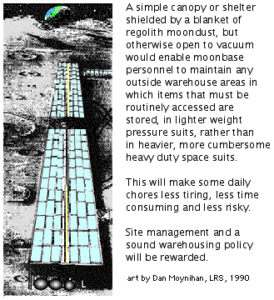[Ra•ma•da (Ra MAH da) – a Spanish word common throughout U.S. treeless plains and desert areas for the shade-providing shelters at roadside rest stops.]
The sketches available of various Moon Base designs, be they the product of NASA think tanks or of outside sources, share an ivory tower penchant for neglecting patterns of likely land use in the immediate vicinity, in the front and back “yards” of principal base structures.
It is inevitable in any Lunar Base operations scenario, that an appreciable portion of routine “out-vac” EVA activity will take place in a few concentrated areas, especially the immediate vicinity of the Base itself, and of its component structures and facilities. There should be a very thorough effort to identify and categorize the types of activities involved and the intensity of use of these “yard” spaces.
Current planning and design provisions make no distinction between those EVA activities on the base doorstep and those spacesuits-required activities at some distance from camp. However, the relatively high intensity of usage of selected close-in areas for storage, staging, repairs, or other repetitive outdoors housekeeping tasks, offers us an opportunity to make such routine activities both safer and easier.
Reducing the risks to personnel by reducing the accumulative need for hours of EVA has been a principle driver for ISS design, however. So one might expect that this proposal*, made in the July 1990 MMM #37 issue would have NASA’s attention. [* republished in MMM Classic #4]
http://www.moonsociety.org/mmm
By designing lightweight, modular, and easily deployable work canopies or “ramadas” strong enough to hold a radiation absorbing blanket* of regolith insulation blown on top, Lunar Base architects can provide built-in cosmic ray, ultraviolet, and micrometeorite protection for these high use activity areas. Providing ramadas will allow those working in such sheltered areas, while still exposed to vacuum, to wear lightweight more comfortable pressure suits. Under such improved conditions, those working outdoors could put in more hours with significantly less fatigue, with lessened vulnerability to random micrometeorites, and with reduced cumulative radiation exposure.
* [the weight per square meter of 2 meters overlay of regolith with a specific gravity of 2.8 g/c3 in 1/6th g is ab out 933k (nearly one metric ton) or 2053 lb. This equates to about 190 lbs/sf]
Under these structures, we could store:
• tanks of scavenged solar wind volatiles, fuels, LOX, etc.
• containers of black water (toilet waste solids) awaiting treatment
• raw materials sorted or beneficiated by on site processing
• products made locally, awaiting domestic use or export
• external utilities & power & power storage systems
• other equipment that must be serviced regularly
• a garage for vehicle maintenance
Not only does such a canopy or ramada make for better and safer working conditions, it provides a thermally stable environment where materials that could be adversely affected by incessant cycling of dayspan heat and nightspan cold can be stored indefinitely. Materials stored there would also be sheltered from the micrometeorite rain.
Such ramadas might be attached to various base structures themselves, in an analogy to awnings and lean-to sheds, or stand free but adjacent to them. They could cover an area continuously or make use of overlapping panels to allow some reflected sunlight to ricochet between top and bottom surfaces into the working spaces below.
Those whose assignments take them beyond such protected yard areas will still require the heavier more cumbersome hardsuits. For some such cases it may be possible to design mobile or “redeployable” ramadas to use at temporary sites of heavy outdoor activity such as can be expected in the field at prospecting sites or with the time-consuming installation of scientific equipment, solar arrays etc.
How could such shelters be constructed? The parts for an initial shelter would have to be brought from Earth. A space frame can be shipped in compact, folded form – we have already done similar things in deploying the International Space Station. It could be covered with a light weight fabric, able to hold the weight load of a foot of sand on Earth – a close approximation to the weight of 2 meters of moondust on the Moon
In time, we should be able to make the equivalent locally, fashioning space frame spars and struts from glass-glass composites. As for a fabric covering, that will be a bit more of a challenge, though layers of fiberglass mesh, topped with a thin fiberglass felt may work.
As Lunar manufacturing develops, the materials, all manufactured on site, could fairly early on become the standard means of providing safe workspaces sheltered from the avoidable “elements” that buffet the exposed Lunar surface. And no doubt, these early products would find many other uses and applications.
As an incentive for early development of the capacity to locally manufacture the components of such shelter systems, NASA might consider the benefits of simply parking the main outpost habitat modules underneath such a shelter, in lieu of shielding them directly, either with plain moondust, or with removable bags or blocks of moondust. Access to the hulls of the various modules would then be a simple matter. But an ever greater advantage would be the ease with which the layout of the various modules could be altered. New modules could be placed where their intended use makes most sense, instead of at one “end” or the “other.” The shelter itself could be easily designed to be expandable.

Without a well thought out warehousing and site management policy, we will end up with an unsightly clutter on the order of the mess exposed to the world by Greenpeace at McMurdo Sound in Antarctica. While a strategy of careful management of high-use yard space, including the use of ramadas, would prevent such unsightly disorder, that is certainly not its principal merit. Disorderly storage would be a symptom of the deeper ill of lackadaisical management of base operations. That same carelessness spawns accidents, both mechanical and human.
Most will accept that we cannot tolerate the expense of mismanagement on the Moon. Part of good base management will consist in providing the safest possible routine working conditions. The added cost of bringing along the materials to erect ramadas over those highest-use outdoor areas around the base will be well justified.
Regardless of what NASA does or does not do, we can model this feature in any future Moon Society-NSS Lunar Analog Research Station.
Next time you see an artist’s depiction of a Moon Base, whether it comes from NASA, the Lunar & Planetary Institute, SSI or Eagle Engineering, or wherever else, ask yourself “what’s wrong with this picture?” If the grounds look neat and uncluttered all without ramada shelters, the rendering will clearly be more akin to science fantasy than science fact. It is hard to interpret such illustrations as anything other than efforts at self-delusion.
If ramadas are essential facilities for Lunar bases, no matter how absent from base concepts currently in vogue, then a national competition to come up with some good design options would be in order. Such a competition should have three categories:
(1) for first generation bases, the most economical use of imported material; per square meter sheltered;
(2) for next generation bases, early practical use of building-materials made on site; and
(3) for mobile and/or redeployable ramadas to be used in the field.
Prize money to entice participation could come from traditional sources such as aerospace contractors, but also from materials industries who wanted to promote the use of their products.
[This article is an expansion of an abstract sent to AIAA in 1990 in response to its solicitation of ideas for Moon/Mars Missions & Bases. [Thanks to Michael J. Mackowski, then of St. Louis Space Frontier Society, for alerting MMM to this opportunity.]
[Artwork by Dan Moynihan]
Peter Kokh

